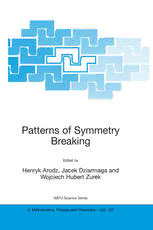
Patterns of Symmetry Breaking PDF
Preview Patterns of Symmetry Breaking
Patterns of Symmetry Breaking NATO Science Series ASeriespresentingtheresultsofscientificmeetingssupportedundertheNATOScience Programme. TheSeriesispublishedbylOSPress,Amsterdam,andKluwerAcademicPublishersinconjunction withtheNATOScientificAffairsDivision Sub-Series I. LifeandBehaviouralSciences lOSPress II. Mathematics,PhysicsandChemistry KluwerAcademicPublishers III.ComputerandSystemsScience lOSPress IV.EarthandEnvironmentalSciences KluwerAcademicPublishers V. ScienceandTechnologyPolicy lOSPress TheNATOScienceSeriescontinuestheseriesofbookspublishedformerlyastheNATOASISeries. The NATOScience Programmeofferssupportforcollaboration incivil science between scientistsof countriesoftheEuro-AtlanticPartnershipCouncil.Thetypesofscientificmeetinggenerallysupported are "Advanced Study Institutes" and "Advanced Research Workshops", although other types of meeting are supported from time to time.The NATO Science Seriescollects togetherthe results of thesemeetings.Themeetingsareco-organizedbijscientistsfromNATOcountriesandscientistsfrom NATO'sPartnercountries- countriesoftheCISandCentralandEasternEurope. Advanced StudyInstitutesarehigh-leveltutorialcoursesofferingin-depthstudyoflatestadvances inafield. Advanced Research Workshops are expertmeetings aimed atcritical assessmentofafield, and identificationofdirectionsforfutureaction. Asaconsequenceoftherestructuring ofthe NATOScience Programmein 1999,theNATOScience Serieshasbeenre-organisedandtherearecurrentlyFiveSub-seriesasnotedabove.Pleaseconsult thefollowingwebsitesforinformationonpreviousvolumespublishedintheSeries,aswellasdetailsof earlierSub-series. http://www.nato.intlscience http://www.wkap.nl http://www.iospress.nl http://www.wtv-books.de/nato-pco.htm I -~ ~ I SeriesII:Mathematics,PhysicsandChemistry- Vol.127 Patterns of Symmetry Breaking edited by Henryk Arodz Jagiellonian University, Cracow, Poland Jacek Dziarmaga Jagiellonian University, Cracow, Poland and Wojciech Hubert Zurek Los Alamos National Laboratory, Los Alamos, U.S.A. Springer-Science+Business Media, B.V. Proceedings of the NATO Advanced Study Institute on Patterns of Symmetry Breaking Cracow, Poland 15-29 September 2002 A C.I.P. Catalogue record for this book is available from the Library of Congress. ISBN 978-1-4020-1745-2 ISBN 978-94-007-1029-0 (eBook) DOI 10.1007/978-94-007-1029-0 Printed an acid-free paper AII Rights Reserved © 2003 Springer Science+Business Media Dordrecht Originally published by Kluwer Academic Publishers in 2003 Softcover reprint ofthe hardcover lst edition 2003 No part of this work may be reproduced, stored in a retrieval system, or transmitted in any form or by any means, electronic, mechanical, photocopying, microfilming, recording or otherwise, without written permission from the Publisher, with the exception of any material supplied specifically for the purpose of being entered and executed on a computer system, for exclusive use by the purchaser of the work. Contents PREFACE SymmetryBreakingandDefects 3 TWB. Kibble Acknowledgments 33 References 34 Liquid4Heand ItsSuperfluidity 37 OJ Griffiths,pc. Hendry, Pv.E. McClintock, H.A. Nichol Acknowledgments 76 References 76 TheRoleofTopologicalDefects inCosmology 83 M. Sakellariadou References 107 CosmicDefectsand ParticlePhysicsConstraints 111 A.C. Davis 4.3.1 Theory-F 125 4.3.2 Theory-D 125 5.1.1 ScalingCosmic Strings 129 5.1.2 Friction DominatedStrings 130 5.1.3 Vortons 130 6.2.1 Constraints 134 References 137 Introduction tothe ModernTheoryofPhaseTransitions 139 loze!Sznajd 1 PhaseTransitions: FromEarly UniversetoIceCube 139 2 SpontaneousSymmetryBreaking 141 3 Symmetry and PhaseTransitions. OrderParameter 142 3.1 Landau theory 143 4 Fluctuations 144 Vi 5 Powerlaws-SaintGraalofthecomplexsystem science 146 5.1 Company sizedistribution 146 5.2 Mortality evolution 146 5.3 Lifespan 147 5.4 Goaldistribution 147 5.5 Family namedistribution 147 5.6 Opinionevolution 147 6 Scaling 148 7 RenormalizationGroup 150 7.1 Renormalizationgrouptransformation 150 7.2 Fixed points 151 7.3 Critical index 152 7.4 Renormalizationgrouptechniques 152 7.4.1 Real-spacerenormalization 153 7.4.2 Uppercriticaldimension 155 7.4.3 Momentum-spacerenormalization 156 8 Final remarks 157 References 158 DefectsinLiquidCrystals: Surfaceand InterfacialAnchoringEffects 161 G.D. Lavrentovich 1 Introduction 161 2 ExperimentalobservationsofLC structures 163 2.1 PolarizingMicroscopyofLiquidCrystals 163 3 Defects in nematics 167 3.1 Topologicalclassification 167 3.2 Disclination textures 171 3.3 Elasticity 172 3.4 Surfaceanchoringphenomena;Equilibrium pointdefects in nematicdroplets 176 4 Defects in SmAand otherLamellarSystems 180 4.1 Elasticity 180 4.2 Dislocations. 183 4.3 FocalConicDomains: Surfacefacetting and Grain boundaries189 5 Summary 193 Acknowledgments 193 References 193 ScalingLawsforFluxonFormation in AnnularJosephsonTunnelJunctions 197 R. Monaco, R.J. Rivers 1 ScalingLawsforFluxonProduction 197 1.1 Background 197 1.2 TheScalingPredictionsForFluxons 198 2 TheExperiment 199 2.1 MeasuringFluxons 199 2.2 Theexperimentalsetup 200 Contents Vll 2.3 The measurements 203 3 Theresults 205 4 Comments,FutureExperimentsandConclusions 206 Acknowledgments 207 References 207 NonholonomicFieldTheoryofVorticesand Defectand theirPhyseTransitions 209 H. Kleinert I Summary 209 2 PhaseTransitionsin Nambu-GoldstoneSystems 211 3 Superfluid4HeandSuperconductors 214 3.1 GradientEnergy 214 3.2 VortexDensity 216 3.3 ThePartitionFunction 217 3.4 InteractionEnergy between Vortices 218 3.5 PhysicalJumpingSurfaces 218 3.6 GaugeField ofSuperflow 219 3.7 DisorderFieldTheory 222 3.8 DisorderTheory ofSuperconductor 225 3.9 Orderversus Disorder 228 3.10 OrderofSuperconductingPhaseTransition-TricriticalPoint 232 3.11 VortexLattices 233 4 AbelianQuarkConfinement 236 References 239 5 Superfluid4He 244 5.1 GradientEnergy 244 5.2 VortexDensity 245 5.3 ThePartitionFunction 246 5.4 InteractionEnergy between Vortices 247 5.5 PhysicalJumpingSurfaces 247 5.6 GaugeFieldofSuperflow 248 5.7 DisorderField Theory 250 5.8 DisorderTheoryofGinzburg-Superconductor 253 5.9 Orderversus Disorder 255 5.10 OrderofSuperconductingPhaseTransition-TricriticalPoint 259 5.11 Vortex Lattices 260 6 Crystals 260 7 Abelian QuarkConfinement 268 Acknowledgments 272 References 272 VorticesandFlatDirections: theUsesofBogomolnyiBounds 273 A. Achucarro 1 Introduction 273 2 Energy boundsfor topologicaldefects 274 3 BogomolnyiboundsforAbrikosov-Nielsen-Olesenvortices 276 Vlll 4 Semilocalstrings 278 5 D-term supersymmetricQED 279 6 Bogomolnyibounds,supersymmetryand fermion zero modes 281 7 Summary 284 References 284 EvolutionofLocalVorticesandInterfaces 287 HenrykArodz 1 Introduction 287 2 Simpleexample-kink inonespatialdimension 288 3 Vortexin theAbelian Higgs model 292 4 Evolutionofinterfacein adissipativesystem 301 5 Remarks 309 References 311 Non-EquilibriumMottTransition in alatticeofBose-Einsteincondensates 313 J. Dziarmaga, A. Smerzi, WHo Zurek, A.R. Bishop 1 Introduction 313 2 Josephsonjunctionarrays 315 3 Thequantum phasemodel 317 4 LinearQuench 318 4.1 Adiabatic transition: TQ -+ 00 319 4.2 Instantaneoustransition: TQ -+ 0 319 4.3 Diabatictransition 319 5 Thegaussianregime 321 5.1 Softmodes 323 5.2 Commensurateversus non-commensurate 325 6 Thecriticalregime 325 7 Fromsuperfluidto insulatingphase 327 8 Conclusion 330 Acknowledgments 331 Appendix 331 References 332 SpontaneousBreakdown ofchiralsymmetry in QCD 335 MaciejA. Nowak Introduction 335 1 QCD in a nut-shell 337 2 Diffusionand QCDVacuum 341 3 Instantons-defectsofthe vacuum 347 4 Spectraluniversalfluctuations in theQCD 350 Contents IX 5 Latticeasaquantumdot 353 6 Prospects 357 Acknowledgments 360 References 364 DomainWall Solutions 367 Tanmay Vachaspati 1 Introduction 367 2 Thekink 368 3 SU(5) X Z2 walls 369 3.1 Domain wall lattice 374 3.2 Formationofdomain walls 376 3.3 Importancein cosmology 378 References 378 PhenomenologyofEffectiveGravity 381 G.£. Volovik 1 Introduction 381 2 Gravity as perturbationofquantum vacuum 382 2.1 Einstein theory in standardformulation 382 2.2 Cosmologicalconstantas vacuumenergy 383 2.3 Sakharovgravityaselasticity ofquantum vacuum 384 2.4 Conservationofenergyandmomentum 384 2.5 Threecomponentsof'cosmicfluid' 385 2.6 Inducedcosmologicalconstant 385 2.7 Gibbs-Duhem relationand cosmologicalconstant 386 2.8 Cosmologicalconstantfrom vacuum perturbations 387 3 Robertson-Walkermetricanditsenergymomentumtensor 388 3.1 Einstein action 388 3.2 Energy-momentumtensorforgravitational field 388 4 Einstein static Universe 389 4.1 Equation ofstateforgravitationalfield 389 4.2 Einstein solution from phenomenology 389 5 deSittersolution asathermodynamicequilibriumstate 390 6 PhenomenologyofGodel Universe 391 6.1 Rotating Universe 391 6.2 Spin susceptibility ofthe vacuum 392 6.3 Equation ofstate for the gravitational field and equilibrium state 393 7 ModificationofEinsteinequationandrelaxationofthevacuumenergy394 7.1 Cosmologicalconstantasevolving parameter 394 7.2 Dissipation in Einsteinequation 395 7.3 Cosmologicalconstantas integrationconstant 396 7.4 FlatUniverse with tworelaxation parameters 397 7.5 Relaxation aftercosmologicalphasetransition 397 7.6 Darkenergyas darkmatter 398 7.7 Analogofquintessence 399 x 8 On energyandmomentumofgravitationalwaves 399 9 Discussion 402 Acknowledgments 403 References 403
